Well, we’re in our fourth week of school and so far so good. Miss A has adjusted to school with ease and Mr. N is right back in the swing of things. While I’m quickly adjusting to not having to juggle sitters and schedules during the day, our evenings are another story. Between homework (for both kids), gymnastics for Miss A, acting and swimming for Mr. N, reading time, play time and of course snuggle time, we’re still trying to find a groove. We also have mom and dad’s work schedules and the much-needed “decompression” time, and oh yes, we need to eat dinner in there too. Sigh. I know this is the same scenario in many homes across the world, and everyone has their strategies to make it through.
One of the strategies that we’ve found works best for us is a little planning ahead – something that we seem to refine each year. This year it works best if Mike and I sit down on Friday to make our meal plan for the next week, taking schedules into consideration. Then Saturday one of us will do the shopping while the other is carting the kids around to activities, and then on Sunday morning we all cook together. We were talking this weekend about how we never would have guessed that a few of the recipes from our blog would have become such staples in our diet. We really do eat a lot differently than we used to – and a lot better than we used to (also thanks to many of your food blogs!).
We also found that we have a few staples that we make weekly. We start Sunday morning with two batches of Kauai Granola. This provides Mike and I with an easy and delicious breakfast that lasts through the week. It’s also perfect with almond milk. I’ve never been one to drink the milk at the end of my cereal, but the almond milk takes on the flavors of the granola and it’s delish! There’s not a drop left in my bowl. 
We then also make a batch of quinoa and make a salad of varying flavors. One of our favorites is a play off of our Southwest Farro Salad, but using quinoa in place of the farro. I’m surprised that quinoa has become such a staple, but we have a lot of fun playing with different international flavor combinations and quinoa provides the perfect canvas from which to create something new each time. 
And much to our surprise we also find ourselves making this vegan taco quite often. The sweet and spicy combination is fantastic and it makes for a ton of leftovers which is super helpful through the week. It’s fast become a family favorite. 
And that brings us to one of our newest staples. You may remember we enjoyed a wonderful visit to Miss C’s farmy back in May. While there, Celi generously sent me home with some kefir grains. 
You can read more about Kefir here, but basically the grains are a live combination of bacteria and yeast which are fed daily with milk. Each day I drain the fermented milk from the grains and add new milk. The fermented milk (kefir milk) can be used for many, many things, but our favorite way to use them is to make fresh bread. Celi has her kefir bread making down to a science and I knew we had to give it a whirl. 
For those of you that have followed the blog for a while know, I am not a bread baker. I’m terrible at it. I kill yeast regularly and I won’t even mention how my sourdough starter came to its gruesome demise, but that’s all changed thanks to Miss C. Kefir bread is wonderfully forgiving. In fact, we have now completely given up buying store-bought bread in place of this wonderful recipe. As I mentioned, each day I strain my kefir and separate the grains and milk. After about five days we have three cups of kefir milk. We combine this milk with three cups of unbleached all-purpose flour. 
Once the milk and flour are combined, the mixture appears sticky and thick. 
We then cover the dough with plastic wrap and a dark towel and leave it sit for 12-36 hours. The longer the mixture sits, the more sour the dough will become – kefir bread tastes remarkably like sourdough bread. As you can see from the image below, after the dough sits it appears bubbly and a bit more soupy. 
After the dough sits and ferments a bit more, it’s time to bake the bread. There are only a few ingredients to this version – honey, salt, olive oil and flour. Incidentally, we have forgotten the olive oil on two occasions and the bread turns out just as well. 
The honey, olive oil and salt are added to the dough and mixed together. 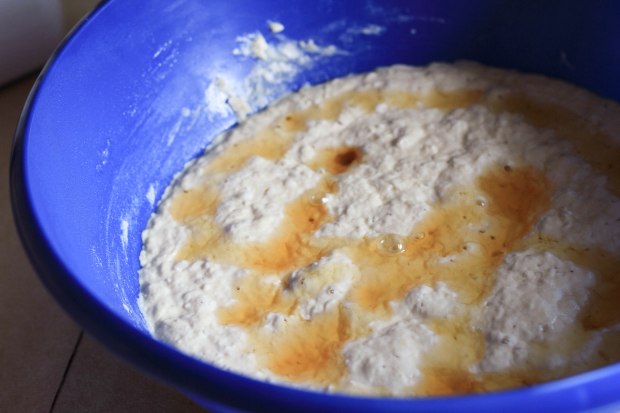
Next we add about three more cups of flour and mix the dough until its sticky and stretchy. 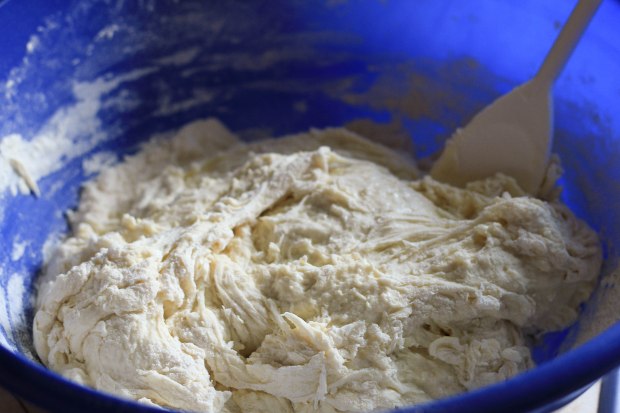
Then we toss some flour on the counter, divide the dough into two and begin kneading one piece at a time. 
This is where kefir bread is most forgiving. The dough uses at least another 1 to 2 more cups of flour on the counter as it’s super sticky, but it softens and becomes smooth very quickly. Typically we knead the dough lightly for only a couple of minutes. 
Next we shape the dough. We made this particular batch while we were at the country house in Michigan, so we went with traditional bread pans. 
We score the loaves and then cover them and let them sit until the dough doubles. 
The timing on the rise varies. Sometimes it takes only an hour, other times it’s taken two. 
Once it’s doubled, or close to doubled in size, it’s time for baking. We bake our bread for 30-40 minutes at 350F and we end up with a nice golden brown crust. 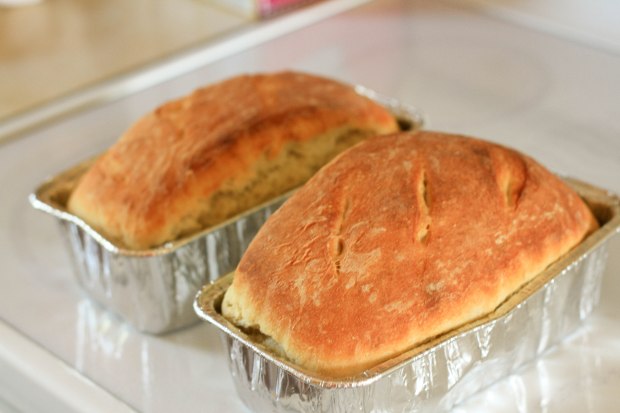
We let the bread cool (and always make sure to pick off a piece from the back because let’s face it – there’s nothing better than fresh bread straight from the oven!) before serving or freezing. 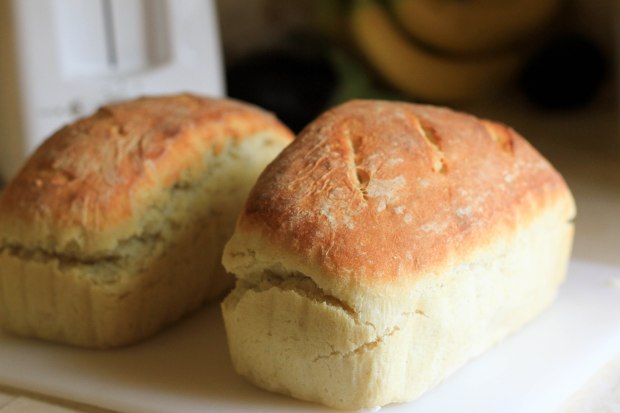
We typically eat one of the fresh loaves through the week and either share or freeze the remaining loaf. 
We use the bread for a side with pasta or cheese, as a sandwich bread, in French toast, for caprese salad, toast, a platter for white bean puree…you name it. It’s a versatile bread. 
As I mentioned, the taste is remarkably similar to a sourdough bread. It’s got that sourdough tang to it and it’s delicious. This bread is easily a 4 spoon recipe for Mike and I. 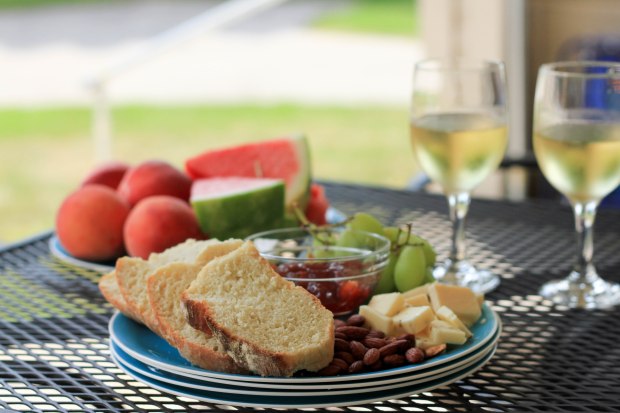
Mr. N is also a big fan of the kefir bread and gives it 4 spoons. He’ll eat it with anything and everything, and he loves being around when it comes out of the oven for that first taste of the loaf. 
Miss A is our lone dissenter on this one. She doesn’t like the sour taste of the bread, but she’ll surprisingly drink the kefir milk straight up. Talk about sour tang! Still, she prefers regular bread to sour bread and only gives this 2 spoons. Not to worry though, I have a recipe for her coming up soon as well as a sweet use for our sour bread (which Miss A did eat right up!). 
Print this recipe: Kefir Bread
So that’s a glimpse into a few of our regular staples. We also have a few other recipes that have made their way to our table more than once including Mike’s lentil burgers, Bermuda French toast, peach ricotta pancakes, cous cous with cumin, baklawa, mussels in white wine cream sauce, pork, apple and wild rice hot dish, grandma’s cobbler, Maine blueberry pie, rosemary peach lemonade, oatmeal cookies and of course, the maple bacon biscuits.
We’ll be back soon with a tasty and sweet use for the kefir bread. And if you notice we aren’t on a regular schedule anymore, you’re right. We find with both kids in school all day, our evenings and weekends are all the more precious to us. Evenings and weekends are the only time we can all be together (and even that depends on the day). So we’ll likely post once a week or once every 10 days or so, but we’re still here. And we’re still cooking. We’re just opting to go off the grid a bit more too. 🙂 Cheers all and if you come across kefir grains – grab some up. They are easy to keep, forgiving to cook with and they make for some tasty fresh homemade bread.